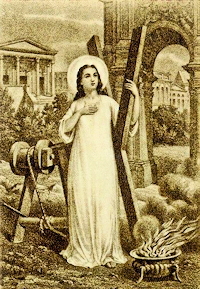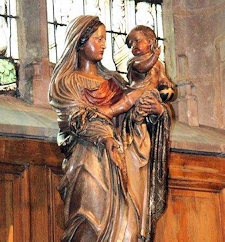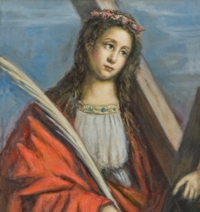Ordinary Time: February 12th
Saturday of the Fifth Week in Ordinary Time
Other Commemorations: St. Eulalia (RM); Our Lady of Argenteuil
» Enjoy our Liturgical Seasons series of e-books!
The Roman Martyrology, commemorates St. Eulalia the most celebrated virgin martyr of Spain. She was a native of Merida, thirteen years of age, and was burnt at the stake in her native city under Diocletian.
The Marian feast of today is Our Lady of Argenteuil. A church was built in Paris by Clovis I containing a portion of the Seamless Garment.
February 7-14 marks the National Marriage Week.
St. Eulalia
 St. Eulalia descended from one of the most prominent families in Spain in 290 AD. She was educated in the Christian religion and was taught the sentiments of perfect piety. From her infancy she distinguished herself by an admirable sweetness of temper, modesty and devotion.
St. Eulalia descended from one of the most prominent families in Spain in 290 AD. She was educated in the Christian religion and was taught the sentiments of perfect piety. From her infancy she distinguished herself by an admirable sweetness of temper, modesty and devotion.
She showed a great love of the holy state of virginity, and by her seriousness and her contempt of dress, ornaments diversions and worldly company, she gave early signs of her sincere desire to lead a heavenly life on earth. Her heart was raised above the world before she was thought capable of knowing it, so that its amusements, which usually fill the minds of youth, had no charms for her, and every day of her life she continued to grow in virtue.
Legends say that she was just twelve years old when the bloody edicts of the Emporer Diocletian were issued in 304, by which it was ordered that all persons, without exception of age, sex, or profession, should be compelled to offer sacrifice to the gods of the empire.
Eulalia, although young, took the publication of this order as a sign of battle, but her mother, observing her impatient ardor for martyrdom, carried her into the country. However, the young saint quickly found a means to make her escape by night, and after much fatigue, arrived at Merida before daybreak.
That same morning, as soon as the court convened, she presented herself before the cruel judge, whose name was Dacian, and reproached him with impiety in attempting to destroy souls by compelling them to renounce the only true God.
The governor then commanded her to be seized. First, employing caresses, Dacian presented to her the advantages which her birth, youth and fortune gave her in the world, and the grief which her disobedience would bring to her parents. Seeing that these temptations had no effect, he began to threaten her, placing the most cruel instruments of torture before her eyes, saying to her, "All this you shall escape if you will but touch a little salt and frankincense with the tip of your finger."
Provoked at these seducing flatteries, she threw down the idol, trampled upon the cake which was laid for the sacrifice and spat at the judge—an action only to be excused by her youth and inattention under the influence of a warm zeal, and fear of the snares which were laid before her.
Upon the judge's order, two executioners began to tear her tender sides with iron hooks, so as to leave the very bones bare. While this was happening, she called the strokes the trophies of Christ. Next, lighted torches were applied to her breasts and sides: under which torment, instead of groans, nothing was heard from her mouth but thanksgivings. The fire at length catching her hair, surrounded her head and face, and the saint was stifled by the smoke and flame.
History says that a white dove seemed to come out of her mouth, and to wing its way upward when the holy martyr expired: at which prodigy the executioners were so much terrified that they fled and left the body.
Her relics are kept with great veneration at Oviedo, where she is honored as patroness. The Roman Martyrology mentions her name on December 10.
—Excerpted from Butler's Lives of the Saints
Patronage: Merida, Spain; Oviedo, Spain, runaways; torture victims; widows
Symbols and Representation: Maiden with a cross, stake, and dove; naked maiden lying in the snow
HIghlights and Things to Do:
- Find out more about St. Eulalia:
- See some iconography of Saint Eulalia.
- Her relics are located in the Barcelona Cathedral.
Our Lady of Argenteuil
 Our Lady of Argenteuil, Paris, built by Clovis I containing a portion of the Seamless Garment. The Abbot Orsini wrote: “This priory preserves a portion of the seamless garment of Our Lord.”
Our Lady of Argenteuil, Paris, built by Clovis I containing a portion of the Seamless Garment. The Abbot Orsini wrote: “This priory preserves a portion of the seamless garment of Our Lord.”
In about the year 500, Clovis was the King of the Franks, but he was not yet a Catholic. Years passed as his wife Clotilda prayed for her husband to convert, yet always King Clovis demurred. Then one fateful day Clovis was engaged in a desperate battle, finding himself sorely bested. At the point of ruin, he cried aloud to the Christian God to assist him, promising to forsake his pagan gods if he were granted a miraculous victory.
Looking up to heaven, Clovis cried:
“Jesus Christ, whom Clotilda declares to be the Son of the Living God, who it is said givest aid to the oppressed and victory to those who put their hope in Thee, I beseech the glory of Thy aid! If Thou shalt grant me victory over these enemies and I test that power which people consecrated to Thy name say they have proved concerning Thee, I will believe in Thee and be baptized in Thy name. For I have called upon my gods, but, as I have proved, they are far removed from my aid. So I believe that they have no power, for they do not succor those who serve them. Now I call upon Thee, and I long to believe in Thee—all the more that I may escape my enemies!”
God was pleased to answer Clovis’ petition immediately, for no sooner had he prayed than his enemies fled the field. Clovis won the battle, and he was a man of his word. Hating his former error, Clovis converted to the True Faith.
It is related in the Gospels that Christ’s executioners played dice over this tunic. According to legend, that tunic was found in the fourth century by Saint Helena, the mother of Emperor Constantine. It was then kept in Constantinople until the eighth century.
In the year 800, the Empress Irene of Byzantium offered Charlemagne the Holy Tunic at his coronation as Emperor of the West. The emperor then gave the relic to the priory of Argenteuil when his daughter, Theodrade, became abbess.
In the year 850, the Normans plundered the village of Argenteuil, including the Basilica of Saint Dennis, but the tunic was hidden in a wall before their arrival. When the abbey was rebuilt in 1003, the relic was restored. It is venerated until the 16th century when it was partially burned by Huguenots in 1567.
During the French Revolution the Benedictine priory was destroyed, and the relic then given to a parish church for safekeeping. In 1793, a priest found it necessary to cut it into pieces and bury them in his garden to protect them from profanation. In 1795, after the priest's imprisonment had ended, the Holy Tunic appeared again and the different fragments were sewn back together.
The Holy Tunic was displayed again in the nineteenth century, and pilgrimages resumed. On the 13 of December in 1983, the parish priest of Saint Dennis discovered the tunic had been stolen. On 2 February 1984, Father Guyard received a phone call from a stranger promising to return the treasure on the condition that their names would be kept secret. That same evening the tunic, with its case, was found in the Basilica of Saint Dennis.
The last solemn exposition of the tunic took place during the Easter holiday in 1984. In six days, approximately 80,000 people came to see the tunic.
The Holy Tunic measures nearly 5’ by 3’ in size. The fibers are wool and of a very regular size. It is a soft, lightweight fabric, and the weaving is uniform and regular with a twisted “Z,” made on a primitive loom. The tunic is remarkable for a tunic woven manually, as it is made without any seam, including the sleeves. The dark brown fabric is typical of the clothing in the early centuries of the Christian era. The fabric was dyed brown, using a method widely in practice at the time by people of modest means. The construction and dyeing show the tunic to date from the time of Christ. It is the garment worn by Christ after the Flagellation and along the road to Calvary as He carried His cross. Christ’s blood and sweat thus impregnate the fabric. In 1985 a test was done showing the blood was type AB. Pollen common to Palestine has also been found in the fabric.
Highlights and Things to Do:
- Read The Exposition of the Holy Tunic of Argenteuil and Holy Tunic of Argenteuil, Seamless Garment, To Be Displayed in 2016 at Aleteia.
- If you are interested in Impressionist paintings see The Impressionists at Argenteuil at the National Gallery of Art.






